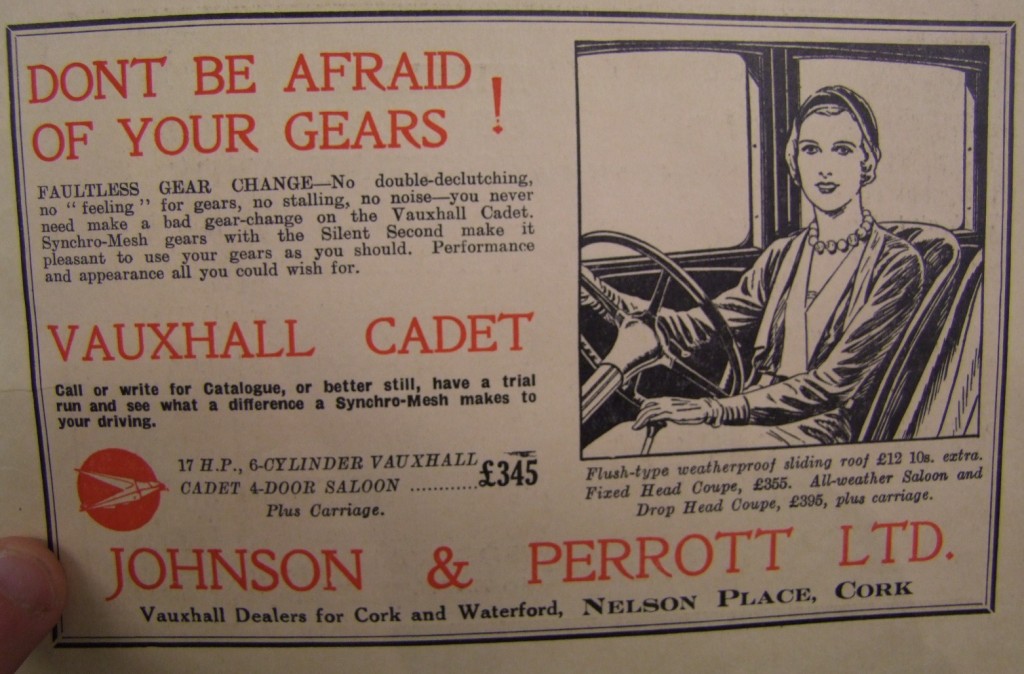
Kieran’s Our City, Our Town
Cork Independent, 27 January 2011
In the Footsteps of St. Finbarre (Part 245)
A National Shop Window
It must have been an impressive site. Certainly the daily newspaper reports in the Cork Examiner and Evening Echo for the summer of 1932 record an energetic effort to draw attention to the aims of the Irish Industrial and Agricultural Fair. Adjacent the Straight Road was over 83 acres of ideas promoting Ireland and all its different parts from native industries to highlighting the Irish way of life. All went a long way in trying to define the emerging national spirit of the Irish Free State. Even the grounds were lit up by rows of tiny overhead lights of national colours of green, white and yellow.
It is quite apparent from the newspaper coverage of the time that the fair committee worked hard to get the crowds in and came up with different themes and ideas in that regard. Over 50,000 people in the first two weeks visited in the first two weeks of the six month run. Conscious of the fact that the fair was on the edge of the City, a new wide footpath was built along the Straight Road. The motor car visitor could park in an organised car park, which accommodated upwards of 3,000 cars under the supervision of the Fair authorities. Special exhibition buses, operated by the Irish Omnibus Company, ran from the city centre to and from the grounds. Special trains running from the western road terminus of the Muskerry Light Railway ran in the evenings to the site and back again.
Efforts were made to bring people from as far as possible. In May, an official of the fair went to meet all the liners coming in at Cobh and spoke to the visitors to get them to visit the fair. By early June, wireless messages were sent to all the liners as they entered Cork harbour. On the 11 June, the following message was sent out today to the M.V. Britannic “Executive Council of Ireland’s National Exhibition, at Cork extends a hearty welcome to all visitors, and co-ordially invite them to see Ireland’s greatest industrial enterprise, covering over 83 acres of exhibits.”
Excursions from Irish towns were encouraged. For example on the 7 May 1932, 240 people from Navan visited. For the 29 June 1932, which was a church holiday, a large number of excursions from towns were arranged from Naas, from West Cork taking in people from Bantry, Skibbereen, Clonakilty, from Kerry taking in people from Tralee and Kenmare and from East Cork, taking in people from Midleton and Youghal. The 29 June was also the day that Eamonn DeValera came to Cork to lay the foundation stone of the new City Hall (opened officially in 1936, celebrating 75 years this year). A number of cross-channel trips to the exhibition were arranged as well as day excursions from England. Most of the UK visitors were from London, Bristol and South Wales. On the 15 June, 30 English tourists came over on the Inishfallen in the early morning taking advantage of the cheap day excursions arranged by the City of Cork Steam Packet Company. Information was also recorded that a number of people from South Africa, New Zealand and Australia visited the grounds, took a keen interest in the Irish goods displayed and made arrangements for samples to be sent home for them.
There was a miniature railway that was installed to take children around the grounds of the Fair. However in May at least 75 per cent of its occupants were adults. A children’s nursery or crèche was managed for ‘tired’ children. They could be left in the care of skilled attendants at the crèche. The crèche was administered with the co-operation of the Cork Child Welfare League. Huge efforts were also made to engage school going children in the Fair project. As essay competition on Irish Free State had alot of entries from Cork Schools and presentations were made by the then Minister of Education, Mr. Patrick Ruttledge. He, nine years previously had been appointed as Minister of Home Affairs, or Eamonn DeValera’s substitute when DeValera was arrested in July 1923 (released in 1924).
The 8 June 1932 was a special day for school children. Special arrangements were made with the railway authorities for reduced fares from all stations throughout the country. On the same day, the fair committee organised a sports display with drills taking place in the sports ground attached to the fair. It was led by a Mr. Bygrove. On the 18 June, a national school sports day was held with hundreds of children from most of the city schools taking part. They assembled in the city centre, were accompanied by bands and marched in processional order to the fair grounds. They carried banners with such inscriptions as “Buy Irish”, “Come to the Fair” and “An t-Aonach Abu”. Indeed on the grounds of the dair as well was a kiosk where a fluent Irish speaker answered any questions in Irish. In that kiosk a visitor’s book was kept where the signature of the Irish-speaking visitors were gathered. It aimed to show the extent of influence and earnestness of the supporters of the language movement throughout the country.
To be continued…
Wanted: Any stories of the 1932 Fair, photographs, memorabilia? Thanks
Captions:
575a. Media ad for Irish Industrial and Agricultural Fair, May 1932 (source: Cork City Library)
575b. Ad for Johnson and Perrott Ltd., in the Fair Catalogue, 1932 (Source: Cork Museum)
